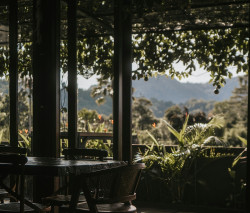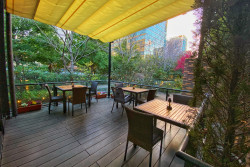
December 3, 2022
A Dining Recommendation Guide to Hatagaya
“A rich and diverse dining culture expected of the inner-city in a more modest setting.”
By Joshua Mueda
Despite its close proximity to Shinjuku and Shibuya, Hatagaya has evolved into a neighborhood that is cozy and relaxed, yet maintains the appeal and pizazz of the inner-city. With two prominent commercial areas in the form of Roku Go Dori and Nishihara Street, along with an array of well-established hotspots mixed in with more residential areas, Hatagaya is home to a rich and diverse food culture with a close-knit community of people with a unique and passionate approach to cuisine at its core.
Cyodo
¥3,000-¥5,000
6-37-10 Honmachi, Shibuya-ku

Opened in April 2022 after operating out of the Yoyogi Hachiman area, shop owner Mona Yamaguchi has friends and family take center stage at Cyodo. An eccentric and fun-loving individual in her own right, Yamaguchi presents her passion to the people of Hatagaya through food and drink. Originally hailing from Mie Prefecture, Yamaguchi and her family spent a good portion of their lives in France, and they maintain that connection up until today through a menu of largely French-style dishes such as pâté de campagne (a blend of ground pork and chicken liver), tomato-simmered tripe, and croque madame —a ham and cheese sandwich that is pan-fried and topped with an egg.
Despite these connections, Yamaguchi is by no means limited to her previous home, and such is best demonstrated in the well-curated natural wine sourced from a variety of regions—including Italy, Georgia and Austria. With largely open-counter seating, the team at Cyodo actively engage in conversation with customers while they work and extend this hospitality right out onto the street—the large window overlooks the outside, where Yamaguchi pops out to serve diners at the small outdoor counter space and greets passersby. Cyodo truly exemplifies community-centered cuisine.
TenTenTen
¥1,000-¥2,000
6-37-6 Honmachi, Shibuya-ku

A short walk down the road from Cyodo is TenTenTen, a Japanese teishoku restaurant exuding a distinct charm all-its-own. Though a bit difficult to notice at first as it is tucked away on the second floor of an apartment building, the subtle store sign — simply marked with three dots (in reference to the restaurant’s name) and “TenTenTen” written in smaller font below, — its inconspicuousness instantly intrigues. Upon entering, you’ll notice the large windows warmly letting light into the interior space.
TenTenTen is a great representation of a local neighborhood spot, offering classic-yet-refined Japanese lunch and dinner staples that find themselves equally at home at a local get-together as they do the blackboard of a corner izakaya. Yumiko Fuse runs the shop, preparing staple dishes like buta no kakuni (simmered pork belly), thick cut and aromatic and served alongside a dab of karashi. For something on the lighter side, the often-changing selection of grilled fish dishes are also staples. In testament to its quality, shop-owners and chefs from the nearby area visit regularly, especially during lunch time.
Buddy-Buddy
¥1,000-¥3,000
1-58-6 Kishita Biru 1F

Being a bit farther from Hatagaya Station, Buddy Buddy is a bit hard to find, yet instantly recognizable from its bold, blue-painted entrance and ostentatious-yet-charming decor overflowing to the outside. Buddy Buddy is an amalgamation of what the free-spirited owners Ikuhiko and Miki Majima could ever want in a storefront: a cafe, a bar, a venue for local events, and a place to display their impressive collection of miscellaneous knick-knacks and records. The food and drink offerings parallel the merriment of the environment, staying true to Buddy-Buddy’s value of comfort and satisfaction. Spaghetti Napolitan, yakisoba, SPAM musubis, and a further array of hearty snacks are served alongside a drink menu of specialty coffees, craft beers, and even high-end champagne. The Majima’s stay active in their community through the variety of events they host as well as offering ukulele lessons and English conversation sessions (Miki spent much of her youth in the United States and speaks fluent English). All the above make Buddy Buddy a hub for human connection.
Pavone Indiano
¥4,000-¥6,000
3-9-13, Hatagaya, Shibuya-ku

Koichi Kurokawa exists in multiple worlds, and upon entering his Hatagaya establishment, you’re transported to his personal dimension. Grungy and atmospheric, the space is decorated with antiques and infused with the fragrance of spices. Pavone Indiano (the Italian word for “Indian Peacock”) is a melding of various culinary worlds where Indian flavors, Italian recipes and techniques, and domestically-sourced Japanese ingredients find harmony.
Items such as the mustard-based curries, which can be served either with basmati rice or focaccia, and the pakora (Indian-style battered and fried dishes) are stars of the menu. Different pastas, many of which are made in-house and flavored with Indian spices, represent this blend of cuisines well. The wine selection is impressive and largely hails from the aforementioned Italy, with Kurokawa providing insight on food-pairings. The signature tiramisu, spiced with anisse and fluffy in texture, is the perfect closer to wind down and take in the Kurokawa’s meticulously constructed atmosphere. Further lending to this, Pavone Indiano hides behind a very unobtrusive entrance with a business-card-sized nameplate to indicate its existence, as if finding the secret back door to creative cuisine.
L’Orchidee
¥1,500-¥3,000
2-29-5 Nishihara, Shibuya-ku

L’Orchidee initially opened as a take-out only storefront on the lively south-side of Hatagaya—towards Yoyogi Uehara, and only recently did owner Kenjiro Miyazaki expand to include in-house dining. Specializing in delicious-yet down-to-Earth French fare of many varieties (and large quantities), the charming corner shop is a spot that can be returned to often with little chance of tedium. The featured fish-of-the-day changes frequently in both type and preparation. The beef miroton is substantial, mixes well with the accompanying rice and macaroni, and is topped with a slice of silky-soft pork belly. A variety of pâté serve as excellent starters, with the venison being a particular stand-out. The array of desserts on display, especially the gateau chocolat (French chocolate cake) and the cloud-shaped cheesecake, serve as excellent finishes. Like other restaurants on this list, family is a core element of L’Orchidee, with Miyazaki’s wife attending to customers. In respect to the shop’s roots, to-go bentos and desserts are a mainstay of operations, so an indulgent meal can be had on-the-go or brought back home.
Aozora
¥2,000-¥5,000
2-7-9, Hatagaya, Shibuya-ku

A mainstay of Hatagaya’s bustling Roku Go Dori, Aozora is one of the city’s most celebrated Mongolian eateries. Its interior is lined with rows of shikishi boards (laminated hard boards for displaying autographs and other imagery) endorsed by many celebrities, but is most populated with those from well-established Mongolian sumo wrestlers. This endorsement can only reflect authenticity, and with owner Sai originally moving from his home country of Mongolia to Tokyo, it’s a point of pride one can be sure he’s held for over 20 years. Indicative of the Mongolian and Northern-Chinese cuisine served, most dishes feature lamb, a mainstay of the former, but a meat that is relatively exotic to the Japanese palette. At Aozora, it can be had in copious amounts and in a variety of ways. In particular, the signature lamb spareribs served upon a sizzling teppanyaki (heavy iron griddle) plate with sliced onions, serves as a luxurious and rich offering to those wanting a representative taste of the cuisine. More distinct dishes such as the roasted lamb’s head, lamb belly, and lamb thigh require a prior reservation and are ideal for large groups. For a more impromptu visit, the lamb chahan (stir-fried rice), lamb curry, meat skewers, and variety of lamb-filled dumplings make an excellent choice.
Miki’s Art Cafe
¥1,000-¥5,000
3-16-3, Hatagaya, Shibuya-ku

Located on a slope of the Nana Go Dori neighborhood, Miki’s Art Cafe’s vivid blue door is something to be stumbled upon on laundry night or walking home from work. An unexpected encounter to her homemade cooking. Miki’s passion and care to the food she serves at the cafe can be tasted in the variety of recipes she comes up with every week in addition to her standard menu with Vegetarian & Vegan option available . If you’re craving for something a little bit different for the night you can request directly to Miki and she would be sure to whip something up! “I’m feeling a bit bloated today, maybe something light on the side?” or “I’m actually on a diet! Can I have the non alcohol alternative for my drink?” For reasons no one knows there are many foreigners who frequent the cafe, creating an open and international atmosphere. Miki’s love for cooking also shows in the various meals of South Asian cuisine in the menu. Furthermore small gatherings or events such as Authentic Curry Night or Croatian Wine Night offer a time to meet new people and enjoy different cuisines. The regulars are very excited and welcoming towards new customers, so solo diners don’t need to be shy to drop by even for an accompanied solitude.







